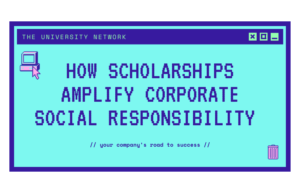Embarking on the noble journey of starting a scholarship fund is a powerful way to impact lives and leave a lasting legacy.
In this comprehensive guide, we delve into the critical aspects of creating a scholarship fund, from determining the right amount to ensuring your investment aligns seamlessly with your values and vision. Our 12-point checklist is designed to simplify the process of supporting students via scholarships, ensuring you can make a meaningful impact with ease.

Need help with your scholarship?
The University Network is happy to help you. Just give us a call at (917) 397-2650, or schedule a time to talk to us below:
Start a Scholarship!
- Start a Scholarship!
- 1. What is the right scholarship amount?
- 2. How many scholarships will you award?
- 3. Who is eligible for the scholarships?
- 4. Will your scholarship be a one-time award or recurring?
- 5. What is your optimum schedule?
- 6. How much will a scholarship program cost?
- 7. How will you integrate your values into the scholarship?
- 8. How will you promote your scholarship?
- 9. Should you integrate social media into the application process?
- 10. How will you select the winner(s)?
- 11. How to avoid tax issues with the scholarship award?
- 12. Consider the Multifaceted Reasons Behind Starting a Scholarship
- Conclusion
1. What is the right scholarship amount?
There’s no magic number. But, the scholarship should be large enough to make an impact and encourage more students to apply. In our experience, awards between $2,500 and $5,000 work best. If you are going to offer less than $2,500, you should consider making the application process a little easier.
While some big companies have the resources to fund big scholarship programs, don’t let a small budget keep you away from sponsoring a scholarship. To a broke college student, every dollar counts!
2. How many scholarships will you award?
This will depend on your budget and why you want to start a scholarship program. If you are working with a small budget, you likely will want to award one scholarship.
If you are a brand with a big scholarship fund, however, you should consider multiple scholarships to attract a wider audience and help more students.
For example, Hyundai Motor America, annually awards five $10,000 scholarships to female students to encourage them to pursue STEM education.
3. Who is eligible for the scholarships?
With nearly 20 million college students and approximately 17 million high school students in the United States, it’s crucial to define the target audience for your scholarship fund. This understanding will enable you to tailor the scholarship fund’s criteria to support the specific groups or interests you aim to benefit.
The eligibility criteria for your scholarship fund can vary widely based on your objectives. You may decide to open the scholarship fund to all college and high school students, restrict it to college students and high school seniors, or focus on particular demographics such as women or students pursuing STEM degrees.
By clearly defining who is eligible, your scholarship fund can effectively reach and assist the intended recipients in line with your support goals.
4. Will your scholarship be a one-time award or recurring?
This will depend on your purpose or cause, whether it’s the launch of a new product, marketing products for specific seasons or time of the year, etc. In our experience, most companies test the water with a scholarship their first year, and come back with another scholarship once they realize how great the benefits are. In many cases, they go bigger after the first time.
The Taco Bell Foundation, for example, awarded $3 million in Live Más Scholarships in 2018. The amount was raised to $4.5 million in 2019, and the Taco Bell Foundation has committed to award more than $7 million in 2021.
You don’t need to have that kind of budget, but it proves the point that even big brands find the ROI on scholarships.
5. What is your optimum schedule?
The purpose and amount of your scholarship(s) will help determine the first and last day of scholarship applications, the announcement of the winners, and when the award(s) would be made.
Be sure to allow sufficient time between the application period and the announcement date to sort through all the applications and pick the winner(s). Also, from our experience, 90 percent of the applications come in at the very end, so make sure you are ready for that.
6. How much will a scholarship program cost?
First, there’s the actual scholarship amount. Then, there are the soft costs — time spent on setting up and administering the program, as well as the cost of outsourcing the process (if you prefer not to manage the process internally). You can choose to outsource all of this to a scholarship management service, like TUN,
7. How will you integrate your values into the scholarship?
A scholarship is a great way for a company to tell its story.
Integrating your values into the scholarship fund is a powerful way to ensure that your company’s brand story resonates with each recipient. By aligning the scholarship criteria with your core values—such as innovation, community service, or leadership—you can attract candidates who embody these ideals. This approach not only reinforces your brand’s identity but also fosters a generation of leaders who share your company’s ethos.
Consider including specific requirements or projects that reflect your values, such as community service hours or innovation challenges, within the scholarship application. This way, the scholarship fund becomes a direct extension of your brand’s commitment to these values, making a meaningful impact on the community and future industry leaders.
8. How will you promote your scholarship?
What good is a scholarship if no one knows about it? So you will need to promote it.
Here are several strategies you can use to ensure your scholarship reaches the right candidates:
- Website and Social Media: Leverage your company’s website and social media platforms to announce the scholarship. Regular posts, stories, and dedicated landing pages can help maintain visibility. Use targeted ads on platforms like Facebook, Instagram, and LinkedIn to reach potential applicants based on their interests and demographics.
- Email Marketing: Send out announcements to your email subscriber list, especially those who are part of a segment that might include potential applicants or influencers who can spread the word.
- Press Releases: Distribute press releases to local and national media outlets, particularly those that focus on education and community news, to gain broader coverage.
- Partnerships with Schools and Universities: Collaborate with high schools, colleges, and universities. Provide counselors and financial aid offices with brochures and detailed information about the scholarship to share with potential candidates.
- Professional and Community Organizations: Engage with professional organizations, community groups, and clubs that align with your scholarship’s target audience. They can promote the scholarship through their networks and newsletters.
- Scholarship Platforms: List the scholarship on popular scholarship websites like TUN.com, Fastweb, and the College Board’s scholarship search tool. These platforms receive high traffic from students actively looking for financial aid.
- Industry Conferences and Events: Utilize conferences, seminars, and workshops to spread the word among a concentrated audience that aligns with the scholarship’s field or focus.
- Influencers and Alumni: Engage with influencers within relevant fields or alumni who have benefited from similar scholarships to share their stories and information about the scholarship.
By using a mix of these promotional strategies, you can maximize the reach and effectiveness of your scholarship campaign, ensuring it attracts a wide array of qualified applicants.
For help with promotion and access to even more enhanced promotion, you can use TUN’s scholarship management services.
9. Should you integrate social media into the application process?
While we like to keep the application process simple, there are ways to have your applicants apply through social media, which gives you the added bonus of more exposure. Take a look on how we did that with our Broke College Student Scholarship.
10. How will you select the winner(s)?
Someone is going to have to cull through the hundreds, if not thousands, of entries. Is this something you will do in-house or will you outsource it? If you intend to do this in-house, be sure to allocate the people for it ahead of time and develop a grading system. In cases where we have handled this for clients, we always recommend that they choose the final winner(s) from a shortlist that we come up with.
11. How to avoid tax issues with the scholarship award?
For U.S. tax purposes, scholarships will not be considered “taxable income” to the student if they are used for educational expenses. In this regard, we usually recommend that your scholarship funds go directly to the school with a caveat that they can be used for any qualified educational expenses, not just tuition. This can help students with respect to their other financial aid. Check here for more information on how to avoid creating tax income to the scholarship recipient.
You may also need to keep track of the scholarship(s) over time. Not all students are ready to redeem the scholarship once it has been awarded.
For tax purposes, scholarships will not be considered “taxable income” to the student if they are used for educational expenses. In this regard, we usually recommend that your scholarship funds go directly to the school with a caveat that they can be used for any qualified educational expenses, not just tuition. This can help students with respect to their other financial aid. Check here for more information on how to avoid creating tax income to the scholarship recipient.
Additionally, it’s important to maintain a tracking system for the scholarship fund over time. Not all students are ready to redeem their scholarships immediately after they have been awarded. Managing your scholarship fund effectively involves monitoring these funds to ensure they are claimed and used in accordance with the fund’s guidelines and timelines. This oversight not only helps comply with tax regulations but also supports the students’ educational journeys by providing them with the resources when they are most needed.
12. Consider the Multifaceted Reasons Behind Starting a Scholarship
Launching a scholarship program is an immensely fulfilling initiative, providing significant advantages not only to the recipients but also to those who establish them. By supporting students, you’re embarking on a noble cause— and it’s only fair that you reap rewards from your generosity.
Reflecting on the core reasons behind starting your scholarship will guide you in shaping a more impactful program. Below are comprehensive reasons why individuals, organizations, or businesses may choose to initiate a scholarship.
Support Access to Education
- Scholarships can make education more accessible to students who may not have the financial means to cover tuition and other related expenses, helping break down barriers to higher education. The Lariat STEM Scholars Program is great examples of scholarships that supports the next generation of brilliant students who grow up in rural areas and have financial need.
Invest in Future Talent
- By supporting students in specific fields of study, benefactors can invest in the development of future professionals and leaders within industries they are passionate about. Ingenovis Health, Inc., a company that provides healthcare staffing, has made the strongest support for the next generation of healthier professionals with $100,000 in scholarships spread over the four programs that help nursing students, allied health professionals and veterans.
Promote Diversity and Inclusion
- Tailored scholarship programs can help promote diversity and inclusion within academic and professional spaces by supporting underrepresented groups, including minorities, women in STEM, first-generation college students, and others. The Hyundai Woman in STEM Scholarship is an example of a program that addresses the gender pay gap and helping women pursue STEM degrees.
Enhance Corporate Social Responsibility (CSR)
- For businesses, starting a scholarship program is an excellent way to demonstrate commitment to CSR, showcasing a genuine investment in the community and the future workforce. The Hyundai Women in STEM Scholarship is an example of a great program that does this by highlighting its own effort to drive inclusiveness in its industry.
Build a Legacy
- Individuals and families may start scholarships as a way to create a lasting legacy that reflects their values and commitments, potentially memorializing a loved one or commemorating a significant achievement or milestone.
Strengthen Brand Awareness and Reputation
- Businesses that offer scholarships can enhance their brand awareness and reputation among key demographics, including potential customers, employees, and the broader community. The Hyundai Women in STEM Scolarship is a great example of this type of scholarship program in that it supports women while showing how the brand cares about helping the next generation of female STEM leaders.
Foster a Skilled Workforce
- Scholarships in specific fields of study can help ensure a steady pipeline of skilled professionals, addressing skill shortages and contributing to the advancement of industries and sectors critical to economic growth.
Encourage Academic Excellence and Innovation
- Competitive scholarships encourage academic excellence and innovation among students, pushing them to excel in their studies and contribute new ideas and solutions in their fields. The Lariat STEM Scholars Program and the Hyundai Woman In STEM Scholarship are great examples of scholarships that support eh next generation of STEM professionals who will change the world.
Create Networking and Mentorship Opportunities
- Starting a scholarship can offer immense personal fulfillment, knowing that you are directly contributing to the success and development of students and positively impacting their lives and futures.
Attract and Retain Talent
- For companies, scholarships can be a strategic tool to attract and retain talent, especially if they include internships, job offers upon graduation, or other professional development opportunities.
In summary, initiating a scholarship program serves as a powerful tool for fostering education, supporting community development, and promoting values of inclusivity and excellence. Whether driven by personal, philanthropic, or business motives, starting a scholarship offers lasting benefits to both the giver and the recipients, creating a ripple effect that extends far beyond the immediate financial assistance.
Conclusion
In conclusion, establishing a scholarship fund is a noble and impactful way to contribute to the academic and professional journeys of students across the nation. From deciding the right scholarship amount to determining the selection process, each step offers an opportunity to align your organization’s values with the aspirations of tomorrow’s leaders.
Whether your budget is modest or substantial, the key is to approach the scholarship program with a clear strategy, integrating your brand’s story and ensuring the initiative is well-promoted to reach deserving candidates. Remember, a well-crafted scholarship program not only aids students financially but also enhances your brand’s reputation and establishes a lasting legacy of support and empowerment. As you embark on this rewarding journey, let your scholarship fund mirror your commitment to education, diversity, and excellence. By doing so, you’re not just funding a student’s education; you’re investing in the future.

Need help with your scholarship?
The University Network is happy to help you. Just give us a call at (917) 397-2650, or schedule a time to talk to us below:
Resources















